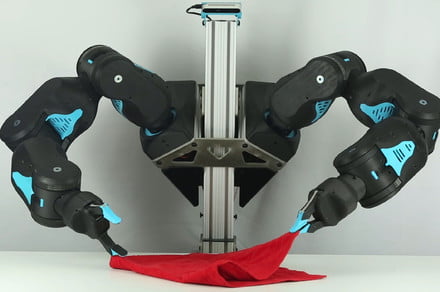[youtube https://www.youtube.com/watch?v=KZ88hPgrZzs]
The idea of having your own assistive robot in the home has been around for at least half a century, promising to usher us into a Jetsons-like future in which we can assign all manner of everyday tasks to a helpful machine. But while such robots have existed in research labs and industry for some time, they’ve not yet made it past our front doors — and the cost is a big reason for this.
That’s something that a team of roboticists at the University of California, Berkeley, have been working to change. They have developed a general-purpose robot, called Blue, able to carry out a range of activities — but also manufacturable at a reasonable cost.
“Blue is a robot designed from the ground-up for the A.I. era,” Pieter Abbeel, project lead, told Digital Trends. “Traditional industrial robots are designed for blind high-speed, sub-millimeter repeatability; they are unsafe around humans, and they tend to cost tens of thousands of dollars — often even hundreds of thousands. Blue sits in a very different part of the design space. [It] is designed to be controlled through visual feedback, to be naturally compliant while still having functional payload, [and] is anticipated to cost only $5,000.”
Although $5,000 is still a large amount of money, it’s far closer to the amount that an average person might have to spend on a labor-saving device. (Consider as a comparison that the Apple II, one of the first personal computers, cost $2,638 when it launched in 1977.)
Stephen McKinley and David Gealy, two of the other researchers on the project, gave us some indication of the types of tasks they expect Blue to excel at. These are likely to be things like in-home automation, such as unloading a dishwasher or putting away groceries. It could also be used as a physical rehabilitation tool.
The team is currently assembling a batch of 10 robots to be sold to early adopters. “Part of this release process has been gauging interest from the research community to see if people actually want what we have made available,” McKinley said. “[Right now], interest is looking strong. The first users will be researchers who will use this system as a platform for development of A.I. algorithms in labs or at their own homes.”
And in the future? “Our sci-fi future — at least the one that we want to see — involves having A.I.-controlled humanoid robots in the world around us,” McKinley said. “We don’t think that can be solved by any one group in existence today, [but] we think that a low-cost shared platform for research will push the field of robotics forward in the right direction.”
Editors’ Recommendations
- This oddball Japanese robot will fold your clothes and do your laundry
- This very talented robotic leg learned to walk all by itself
- Grab a magnifying glass and feast your eyes on the world’s tiniest walking robot
- In the future, welding robots could be controlled by operators’ thoughts
- ANYmal dog robot can get back on its feet when someone pushes it over

